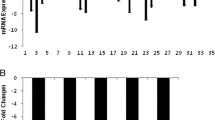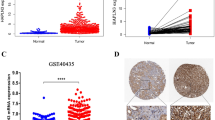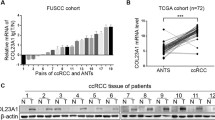Abstract
Objective
To study the correlation between hyaluronic acid (HA), hyaluronic acid synthase (HAS) and human renal clear cell carcinoma (RCCC).
Methods
The expression of three HAS isoforms’ gene and HA in 93 RCCC tissues, 27 nephridial tissues by the side of RCCC from two hospitals were measured with Real-Time RT-PCR、 Western Blot and immunohistochemical methods and analyzed.
Results
All RCCC and adjacent normal tissues expressed three HASs’ mRNA & protein; at the mRNA level, both RCCC and adjacent normal tissues, expressed more HAS3 than HAS1 or HAS2, their differences were statistically significant (all P values <0.05); but, at the protein level, all HAS isoforms presented the equivalent expression. Compared with the adjacent non-neoplastic kidney tissues, the expression of all HAS isoforms’ mRNA in RCCC tissues were increased evidently and their differences were significant (all P values <0.0001); but at the protein level, only the expression of HAS3 increased evidently (P=0.022). In all adjacent normal tissues, more than 80% renal tubular cells strongly expressed HA, however, only the minority RCCC cases (16/93) presented weakly positive HA staining in few cancer nests (5%–30%), the difference were significant (P<0.0001). In RCCC tissues subgrouped according to clinical stage, pathological grade, lymphatic metastasis or not and distant metastasis or not, the HASs’ mRNA & protein differential expression all had no statistical significance (all P values >0.05).
Conclusion
Different from other malignancy, HA and HASs (except for HAS3) may not play important roles in the biological progress of human RCCC.
Similar content being viewed by others
References
Toole BP, Hascall VC. Hyaluronan and tumor growth. Am J Pathol 2002; 161:745–747.
Itano N, Sawai T, Yoshida M, et al. Three isoforms of mammalian hyaluronan synthases have distinct enzymatic properties. J Biol Chem 1999; 274:25085–25092.
Cai JL, Xin DQ, Lv TJ, et al. The expression and significance of various genes of hyaluronic acid synthase isoforms in different stage/grade human bladder transitional cell carcinoma. J Clin Urol (in Chinese) 2008; 23:348–352.
Yu TM, Yao G. Development of real-time PCR assay for detection and quantitation of substance P mRNA in rats using SYBR Green. J Jilin University (Medicine Edition) (in Chinese) 2008; 34:1086–1088.
Nakata S, Yoshida T, Horinaka M, et al. Histone deacetylase inhibitors up-regulate death receptor 5/TRAIL-R2, and sensitize apoptosis induced by TRAIL/APO2-L in human malignant tumor cells. Oncogene 2004; 23:6261–6271.
Cai JL, Ye ZhQ, Yang WM, et al. The significance and expression of hyaluronic acid in human bladder transitional cell carcinoma and papilloma of bladder. Chin J Exp Surg (in Chinese) 2004; 21:1226–1228.
Rosines E, Schmidt HJ, Nigam SK. The effect of hyaluronic acid size and concentration on branching morphogenesis and tubule differentiation in developing kidney culture systems: potential applications to engineering of renal tissues. Biomaterials 2007; 28:4806–4817.
Bartolo RC, Donald JA. The distribution of renal hyaluronan and the expression of hyaluronan synthases during water deprivation in the Spinifex hopping mouse, Notomys alexis. Comp Biochem Physiol A Mol Integr Physiol 2007; 148:853–860.
Beck-Schimmer B, Oertli B, Pasch T, et al. Hyaluronan induces monocyte chemoattractant protein-1 expression in renal tubular epithelial cells. J Am Soc Nephrol 1998; 9:2283–2290.
Rügheimer L, Carlsson C, Johnsson C, et al. Renal hyaluronan content during experimental uncontrolled diabetes in rats. J Physiol Pharmacol 2008; 59:115–128.
Declèves AE, Caron N, Nonclercq D, et al. Dynamics of hyaluronan, CD44, and inflammatory cells in the rat kidney after ischemia/reperfusion injury. Int J Mol Med 2 2006; 18:83–94.
Asselman M, Verhulst A, Van Ballegooijen ES, et al. Hyaluronan is apically secreted and expressed by proliferating or regenerating renal tubular cells. Kidney Int 2005; 68:71–83.
Pummill PE, DeAngelis PL. Alteration of polysaccharide size distribution of a vertebrate hyaluronan synthase by mutation. J Biol Chem 2003; 278:19808–19814.
Kuang DM, Wu Y, Chen N, et al. Tumor-derived hyaluronan induces formation of immunosuppressive macrophages through transient early activation of monocytes. Blood 2007; 110:587–595.
Koyama H, Kobayashi N, Harada M, et al. Significance of tumor-associated stroma in promotion of intratumoral lymphangiogenesis: pivotal role of a hyaluronan-rich tumor microenvironment. Am J Pathol 2008; 172:179–193.
Ohashi R, Takahashi F, Cui R, et al. Interaction between CD44 and hyaluronate induces chemoresistance in non-small cell lung cancer cell. Cancer Lett 2007; 252:225–234.
Author information
Authors and Affiliations
Corresponding author
Rights and permissions
About this article
Cite this article
Cai, Jl., Li, M. & Na, Yq. Correlation between hyaluronic acid, hyaluronic acid synthase and human renal clear cell carcinoma. Chin. J. Cancer Res. 23, 59–63 (2011). https://doi.org/10.1007/s11670-011-0059-6
Received:
Accepted:
Published:
Issue Date:
DOI: https://doi.org/10.1007/s11670-011-0059-6




